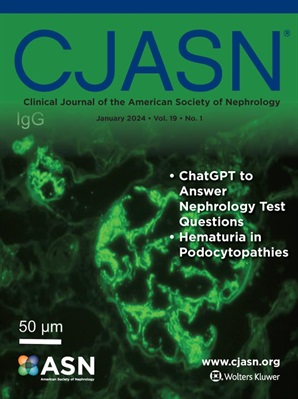Frailty in Adults with Chronic Kidney Disease and Validation of the Kidney Failure Risk Equation in Frailty Sub-Groups.
IF 8.5
1区 医学
Q1 UROLOGY & NEPHROLOGY
Clinical Journal of the American Society of Nephrology
Pub Date : 2025-05-21
DOI:10.2215/cjn.0000000739
引用次数: 0
Abstract
BACKGROUND AND HYPOTHESIS Frailty is common amongst adults with chronic kidney disease (CKD) and its presence can influence clinical outcomes such as advancing CKD and mortality. Clinical guidelines recommend the use of the Kidney Failure Risk Equation (KFRE) to guide management of CKD.Our aim was to validate KFRE by frailty status and assess whether model performance could be improved by using cystatin based estimated glomerular filtration rate (eGFR) equations and to assess the impact of accounting for competing mortality risk. METHODS We studied adults from the prospective research cohort UK Biobank with CKD G3-5 (eGFR <60mL/min/1.73m2) by any of the three CKD-EPI consortium eGFR equations: eGFR creatinine (eGFRcr), eGFR cystatin (eGFRcys) and eGFR creatinine-cystatin (eGFRcr-cys)). Frailty was assessed by a modified frailty phenotype and two cumulative deficit frailty indices. Kidney failure was defined as long-term dialysis or kidney transplantation. Model assessment included discrimination, calibration and overall fit at two- and five-years. RESULTS The prevalence of frailty by one or more measures was 35% (N=8,533). Those classed as frail had a higher discrepancy between eGFRcys and eGFRcr compared to the non-frail group (-15.8 vs -6.9 ml/min/1.73m2). Discrimination of KFRE was good (area under receiver operating characteristic curve ≥0.88 across all frailty sub-groups and eGFR equations). Kidney failure at five years was under-estimated in individuals with frailty (observed/expected (O/E) ratio 1.70; 95% CI 1.55-1.85). Calibration-in-the-large improved when eGFRcr was replaced by eGFRcys (five-years O/E ratio 1.20; 95%CI 1.05-1.35). Overestimation of kidney failure risk in analyses that do not account for competing mortality risk compared to those that do, was most apparent in the frailty group and the higher KFRE predicted risk groups. CONCLUSION KFRE under-estimates kidney failure risk for individuals with CKD and frailty. Risk prediction improved for those with frailty when cystatin-based eGFR equations are utilized and when analyses account for competing risk of mortality. These factors should be considered when KFRE calculation is used in clinical practice in individuals with frailty.成人慢性肾脏疾病的衰弱和衰弱亚组肾衰竭风险方程的验证。
背景与假设衰弱在成人慢性肾脏疾病(CKD)患者中很常见,它的存在会影响临床结果,如CKD进展和死亡率。临床指南推荐使用肾衰竭风险方程(KFRE)来指导CKD的管理。我们的目的是通过虚弱状态来验证KFRE,并评估是否可以通过使用基于胱抑素的估计肾小球滤过率(eGFR)方程来改善模型性能,并评估考虑竞争性死亡风险的影响。方法:我们研究了来自UK Biobank前瞻性研究队列的CKD G3-5 (eGFR <60mL/min/1.73m2)的成人,通过三种CKD- epi联盟eGFR方程中的任何一种:eGFR肌酐(eGFRcr), eGFR胱抑素(eGFRcys)和eGFR肌酐-胱抑素(eGFRcr-cys))。脆弱性通过改良的脆弱性表型和两个累积缺陷脆弱性指数进行评估。肾功能衰竭定义为长期透析或肾移植。模型评估包括2年和5年的判别、校准和整体拟合。结果一项或多项指标的衰弱患病率为35% (N=8,533)。与非虚弱组相比,虚弱组的eGFRcys和eGFRcr之间的差异更高(-15.8 vs -6.9 ml/min/1.73m2)。KFRE的鉴别性较好(所有衰弱亚组和eGFR方程的受试者工作特征曲线下面积≥0.88)。在虚弱的个体中,低估了5年肾衰竭(观察/预期(O/E)比为1.70;95% ci 1.55-1.85)。当eGFRcr被egfrys取代后,大规模校准得到改善(5年O/E比1.20;95%可信区间1.05 - -1.35)。在不考虑竞争死亡风险的分析中,与考虑竞争死亡风险的分析相比,对肾衰竭风险的高估在虚弱组和KFRE预测较高的风险组中最为明显。结论kfre低估了CKD和虚弱患者的肾衰竭风险。当使用基于胱抑素的eGFR方程和当分析考虑竞争死亡风险时,对虚弱者的风险预测得到改善。当KFRE计算在临床实践中用于虚弱个体时,应考虑这些因素。
本文章由计算机程序翻译,如有差异,请以英文原文为准。
求助全文
约1分钟内获得全文
求助全文
来源期刊
CiteScore
12.20
自引率
3.10%
发文量
514
审稿时长
3-6 weeks
期刊介绍:
The Clinical Journal of the American Society of Nephrology strives to establish itself as the foremost authority in communicating and influencing advances in clinical nephrology by (1) swiftly and effectively disseminating pivotal developments in clinical and translational research in nephrology, encompassing innovations in research methods and care delivery; (2) providing context for these advances in relation to future research directions and patient care; and (3) becoming a key voice on issues with potential implications for the clinical practice of nephrology, particularly within the United States. Original manuscript topics cover a range of areas, including Acid/Base and Electrolyte Disorders, Acute Kidney Injury and ICU Nephrology, Chronic Kidney Disease, Clinical Nephrology, Cystic Kidney Disease, Diabetes and the Kidney, Genetics, Geriatric and Palliative Nephrology, Glomerular and Tubulointerstitial Diseases, Hypertension, Maintenance Dialysis, Mineral Metabolism, Nephrolithiasis, and Transplantation.

 求助内容:
求助内容: 应助结果提醒方式:
应助结果提醒方式:


